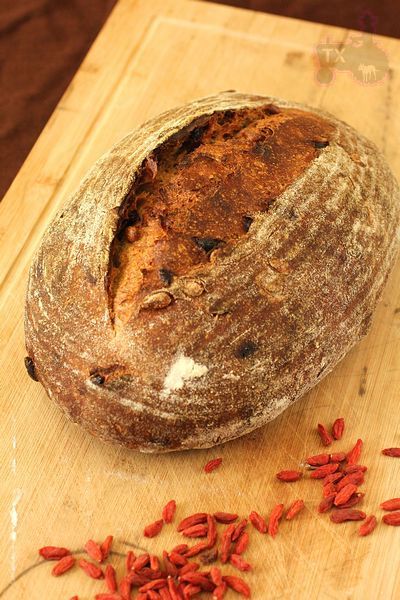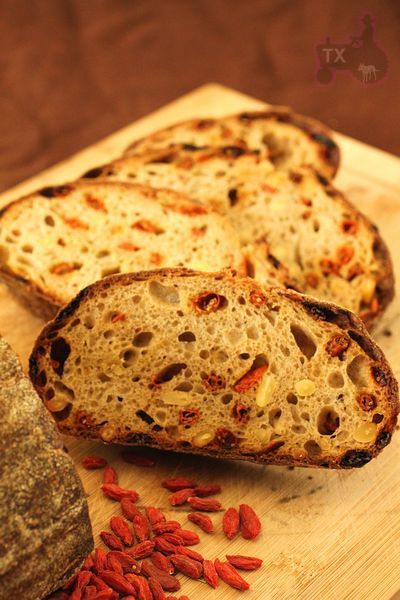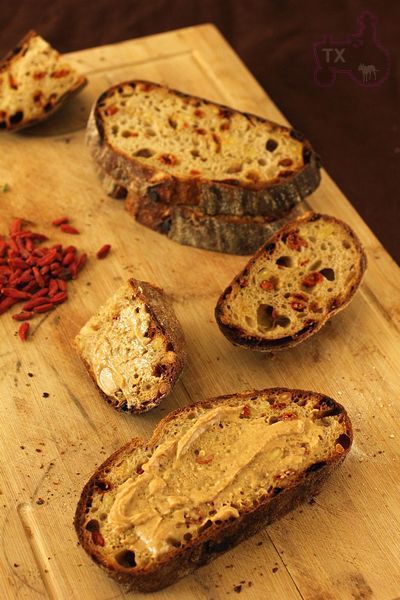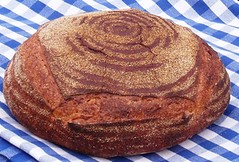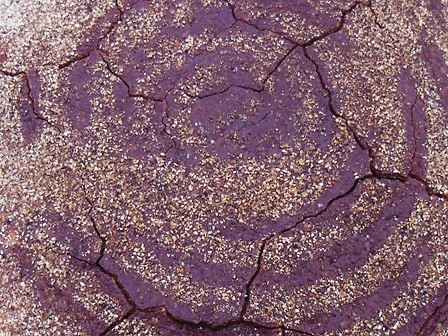So, this is the first report on my trial of T55 flour my daughter brought back from Paris. I used to use Shipton’s T55 years ago for a while, but this is the first time I’ve ever used T55 actually made in France….though it’s just a supermarket’s own brand flour, so definitely not the highest quality one. But to be fair, the supermarket my daughter bought it from was Monoprix, which, according to Wiki, is “considered an up-scale chain and its business model was the inspiration for Waitrose,” in spite of its very un-assuring name :p, so hopefully it’s at least not the lowest of the lowly, bog-standard flour. ::fingers crossed::

The first thing I noticed when I opened the bag was how yellowy the colour was and also it looked less smooth?/less fluid?/a bit more sticky? (sorry, can't find a good way to describe) than other white flour I use.

< (from left to right) Waitrose Organic Strong, Monoprix T55, Waitrose Canadian Very Strong>
I ‘d always thought Waitrose Organic had creamier shade of colour than other flours I’d used (except for Waitrose's Leckford Estate flour which had even creamier shade), but compared to the T55, it looked more pinkish in comparison, which was a surprise.
The biggest reason I wanted authentic French T55 was to find out how much difference it would make in my baguette, both taste and shape (both outside and inside) and to use the experience as my future bench mark when mixing UK flours to improvise. So I proceeded with my regular poolish baguette recipe, of which formula I posted in my last blog.
The only change I made this time was replacing all the flours (Strong, Plain and WW) in the formula, except for small rye in the poolish, with T55 and also omitting wheatgerm completely, because I wanted to see how pure T55 tasted.
The instant I added water to the flour to make poolish, I noticed it’s very different. For a short while the flour didn’t ‘dissolve’ as easily as the strong flour (Waitrose Organic) and looked a bit like when I added water to Dove’s Pasta Flour I blogged about before which contained Durum flour. A bit grainy and more lumpy, similar to when you mix water into semolina......just for a short time initially.
After a few more stirring, the flour and water mixed well but it looked a bit more ‘fluid’ than my usual poolish, most likely because T55 (10.5%) is much lower in protein than my Strong (12.9%) .
When mixed well, I left it to ripe at room temperature, as in the above mentioned formula. After 7 hrs, I saw the poolish reached its peak, so I proceeded with the rest of the formula. Again, when I added all the ingredients and poolish, I noticed immediately the dough was much softer than my usual mix. When I did S&F, again it was much softer to touch and more extensible. In utter desperation a few years ago for not being able to obtain T55 very easily here, I had once attempted making a baguette only using UK plain flour which had a similar protein level as this T55, but it felt different from that. This time, it was extensible but there was a kind of strength in it, like a ‘core’ which 100% plain flour dough didn’t have. I thought, ‘Aha! This is how T55 make a difference in resultant baguettes!’ and put the dough in the fridge for long, cold retardation for 21 hrs, as usual.
After 21 hrs……The dough hadn’t gained as much volume as my usual improvised-flour dough. Looked very flat and had hardly any large bubbles on the surface which I always see a few of them with my regular baguette dough after the cold retard. And when I turned it out onto the worktop, it just spread just like a very high-hydration dough, almost like this video by Peter Reinhart.
So there was just NO WAY I could shape this into baguettes with the state of gloopy dough. I contemplated for a while if I should do extra sets of S&F until the dough was strong enough, but I knew from my past experiences it would only give you the crumb with uniform texture without much big airy holes to speak of, unless you do another long, cold retardation after shaping, which was not an option at the time.
So in the end, this is what it ended up as. A ciabatta with baguette-ish crumb….or a baguette who wanted to pretend it was a ciabatta, whichever you prefer to call. :p


(Hope nobody notices a half-bitten piece I discreetly put back among them....)

The crumb wasn't open nor did it have larger holes I would've liked, obviously because 1) I didn't slash the top because it was going to be like a ciabatta, 2) the hydration was not high enough to be a ciabatta with typically open crumb with lots of BIG holes because it was supposed to be a baguette......::sigh::
Sorry, it’s such an anti-climax. But I must say the flavour was AMAZING! It had such a deep and more complex flavour than my usual UK flour baguettes, especially the crust. And the aroma which came out from the oven during baking was quite different, too: more wheaty and nutty. Also the crumb had much darker colour, which I associate with really good baguettes. And the most interesting thing is its saltiness. Even I added exactly the same amount of salt as usual, the saltiness was a little more predominant compared to my regular baguettes…or many other baguettes I’ve had before. It’s not actually ‘saltier,’ in anyway, the amount of ‘saltiness’ you taste is the same. But for some reason ‘the saltiness’ stood out. It really brought back the memories of excellent baguettes I had in the long past and reminded me its lovely saltiness, Yeah….a gooooooood baguette was always salty, never sweet. I’d forgotten that……
lumos








